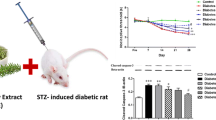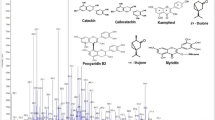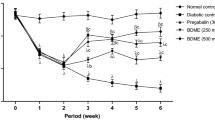Abstract
Painful diabetic neuropathy (PDN) is known to adversely affect psychosocial functioning by enhancing levels of anxiety and depression. This study was designed to verify the antihypernociceptive, anxiolytic, and antidepressant-like effects of Combretin A and Combretin B (two triterpenes cycloartane-type isolated from the leaves of Combretum fragrans) in streptozotocin-induced diabetic neuropathy in mice. PDN was induced in mice by the administration of streptozotocin (STZ, 200 mg/kg, i.p.). The effect of oral administration of Combretin A (25 and 50 mg/kg) and Combretin B (25 and 50 mg/kg) on nociception (mechanical allodynia, thermal hyperalgesia, cold allodynia, and chemical hyperalgesia), anxiety (elevated plus maze, light-dark box test, social interaction), and depressant (open field test, forced swimming test, tail suspension test) was evaluated. Combretin A (25 and 50 mg/kg) and Combretin B (25 and 50 mg/kg) caused antihypernociceptive, anxiolytic, and antidepressant-like effects in in STZ-induced diabetic neuropathy in mice. Both compounds also caused a decrease in blood glucose and improved body weight in treated animals. They also significantly (p < 0.001) reduced tumor necrosis factor alpha (TNF-α), interleukin-1 beta (IL-1β), malondialdehyde (MDA), and nitric oxide (NO) production in serum and sciatic nerves, and, significantly (p < 0.001) increased superoxide dismutase (SOD) and catalase (CAT) activity in serum, sciatic nerves, and brain. Combretin A and Combretin B also showed a great systemic effect, conserving values of evaluated parameters close to normal in treated mice. The results of this study confirm the antihypernociceptive, antianxiety, and antidepressant activities of Combretin A and Combretin B.













Similar content being viewed by others
Data availability
All data supporting our findings are adequately contained within the manuscript.
References
Al-Enazi MM (2013) Ameliorative potential of rutin on streptozotocin induced neuropathic pain in rat. Afr J Pharm Pharmacol 7(41):2743–2754
Almdal TP, Vilstrup H (1988) Strict insulin treatment normalizes the organic nitrogen contents and the capacity of urea–N synthesis in experimental diabetes in rats. Diabetes 31:114–118
Apfel SC, Asbury AK, Bril V, Burns TM, Campbell JN, Chalk CH, Dyck PJ, Dyck PJ, Feldman EL, Fields HL, Grant IA, Griffin JW, Klein CJ, Lindblom U, Litchy WJ, Low PA, Melanson M, Mendell JR, Merren MD, O'Brien PC, Rendell M, Rizza RA, Service FJ, Thomas PK, Walk D, Wang AK, Wessel K, Windebank AJ, Ziegler D, Zochodne DW (2001) Positive neuropathic sensory symptoms as endpoints in diabetic neuropathy trials. J Neurol Sci 189:3–5
Baron R, Binder A, Wasner G (2010) Neuropathic pain: diagnosis, pathophysiological mechanisms, and treatment. Lancet Neurol 9(8):807–819
Barrett AM, Lucero MA, Le T, Robinson RL, Dworkin RH, Chappell AS (2007) Epidemiology, public health burden, and treatment of diabetic peripheral neuropathic pain: a review. Pain Med 8(Suppl. 2):S50–S62
Bhattamisra SK, Singh PN, Singh SK, Kumar V (2007) Anxiolytic activity of Marsilea minuta Linn. Journal of Herbal Medicine and Toxicology 1:15–20
Biella GE, Groppetti A, Novelli A, Fernández-Sánchez MT, Manfredi B, Sotgiu ML (2003) Neuronal sensitization and its behavioral correlates in a rat model of neuropathy are prevented by a cyclic analog of orphenadrine. J Neurotrauma 20:593–601
Bolajoko EB, Mossanda KS, Adeniyi F, Akinosun O, Fasanmade A, Moropane M (2008) Antioxidant and oxidative stress status in type 2 diabetes and diabetic foot ulcer. S Afr Med J 98:614–617
Bonizzi G, Karin M (2004) The two NF-κB activation pathways and their role in innate and adaptive immunity. Trends Immunol 25:280–288
Bortalanza LB, Ferreira J, Hess SC, Monache FD, Yunes RA, Calixto JB (2002) Anti-allodynic action of the tormentic acid, a triterpene isolated from plant, against neuropathic and inflammatory persistent pain in mice. Eur J Pharmacol 453:203–208
Boulton AJM, Malik RA, Arezzo J, Sosenko JM (2000) Diabetic neuropathy: technical review. Diabetes Care 27:1458–1487
Brownlee M (2005) The pathobiology of diabetic complications: a unifying mechanism. Diabetes 54:1615–1625
Calcutt NA (2004) Experimental models of painful diabetic neuropathy. J Neurol Sci 220:137–139
Calixto JB, Beirith A, Ferreira J, Santos AR, Cechinel FV, Yunes RA (2000) Naturally occurring antinociceptive substances from plants. Phytother Res 14:401–418
Celec P (2004) Nuclear factor Kappa B-molecular biomedicine: the next generation. Biomed Pharmacother 58:365–371
Chan AW, MacFarlane IA, Bowsher DR (1990) Chronic pain in patients with diabetes mellitus: comparison with non-diabetic population. Pain Clin 3:147–159
Chang CY, Guo HR, Tsai WC, Yang KL, Lin LC, Cheng TJ, Chuu JJ (2015) Subchronic arsenic exposure induces anxiety-like behaviors in normal mice and enhances depression-like behaviors in the chemically induced mouse model of depression. Biomed Res Int 2015:159015
Chaplan SR, Bach FW, Pogrel JW, Chung JM, Yaksh TL (1994) Quantitative assessment of tactile allodynia in the rat paw. J Neurosci Methods 53:55–63
Christman JW, Blackwell TS, Juurlink BHJ (2000) Redox regulation of nuclear factor Kappa B: therapeutic potential for attenuating inflammatory responses. Brain Pathol 10:153–162
Crawley J, Goodwin FK (1980) Preliminary report of a simple animal behavior model for the anxiolytic effects of benzodiazepines. Pharmacol Biochem Behav 13:167–170
Daousi C, MacFarlane IA, Woodward A, Nurmikko TJ, Bundred PE, Benbow SJ (2004) Chronic painful peripheral neuropathy in an urban community: a controlled comparison of people with and without diabetes. Diabet Med 21:976–982
Davies M, Brophy S, Williams R, Taylor A (2006) The prevalence, severity, and impact of painful diabetic peripheral neuropathy in type 2 diabetes. Diabetes Care 29:1518–1522
Dawe A, Wabo Fotso KGD, Bankeu Kezetas JJ, Fawaia Y, Alid Shaiq M, Ngadjuie Tchaleu B (2016) Combretins A and B, new cycloartane-type triterpenes from Combretum fragrans. Helv Chim Acta 99:617–620
De Groot M, Anderson R, Freedland KE, Clouse RE, Lustman PJ (2001) Association of depression and diabetes complications: a meta-analysis. Psychosom Med 63:619–630
Decosterd I, Woolf CJ (2000) Spared nerve injury: an animal model of persistent peripheral neuropathic pain. Pain 87(2):149–158
Djordjevic A, Bursać B, Veličković N, Vasiljević A, Matić G (2015) The impact of different fructose loads on insulin sensitivity, inflammation, and PSA-NCAM-mediated plasticity in the hippocampus of fructose-fed male rats. Nutr Neurosci 18:66–75
Durst T, Merali Z, Arnason JT, Sanchez-Vindas EP, Poveda AL (2002) Anxiolytic Marcgraviaceae compositions containing betulinic acid, betulinic acid derivates, and methods. WO/2002/091858
Dworkin RH, Gitlin MJ (1991) Clinical aspects of depression in chronic pain patients. Clin J Pain 7:79–94
Dworkin RH, O’Connor AB, Audette J, Baron R, Gourlay GK, Haanpää ML, Kent JL, Krane EJ, LeBel AA, Levy RM, Mackey SC, Mayer J, Miaskowski CD, Raja SN, ASC R, Schmader KE, Stacey B, Stanos S, Treede RD, Turk DC, Walco GA, Wells CD (2010) Recommendations for the pharmacological management of neuropathic pain: an overview and literature update. Mayo Clin Proc 85(3):S3–S14
Dyck PJ, Davies JL, Litchy WJ (1997) Longitudinal assessment of diabetic polyneuropathy using a composite score in the Rochester diabetic neuropathy study cohort. Neurology 49:229–239
Fatani AJ, Al-Rejaie SS, Abuohashish HM, Al-Assaf A, Parmar MY, Ola MS, Ahmed MM (2015) Neuroprotective effects of Gymnema sylvestre on streptozotocin-induced diabetic neuropathy in rats. Exp Ther Med 9:1670–1678
Felipe FCB, Filho JTS, Souza LO, Silveira JA, Uchoa DEA, Silveira ER, Deusdênia LPO, De Barros Viana GS (2007) Piplartine, an amide alkaloid from Piper tuberculatum, presents anxiolytic and antidepressant effects in mice. Phytomedicine 14:605–612
File SE (1996) The use of social interaction as a method for detecting anxiolytic activity of chlordiazepoxide like drugs. J Neurosci Methods 2:219–238
Gonder-Frederick LA, Cox DJ, Ritterband LM (2002) Diabetes and behavioral medicine: the second decade. J Consult Clin Psychol 70:611–625
Gul H, Yildiz O, Dogrul A, Yesilyurt O, Isimer A (2000) The interaction between IL-1beta and morphine: possible mechanism of the deficiency of morphine-induced analgesia in diabetic mice. Pain 89:39–45
Hache G, Guiard BP, Le Dantec Y, Orvoën S, David DJ, Gardier AM, Coudore F (2012) Antinociceptive effects of fluoxetine in a mouse model of anxiety/depression. Neuro Report 23(9):525–529
Halliwell B (1991) Drug antioxidant effects. A basis for drug selection. Drugs 42:569–605
Hanson JR (2003) Natural products: the secondary metabolites. The Royal Society of Chemistry, Cambridge, pp 112–121
Hasanein P, Soltani N (2009) Effects of the endocannabinoid transport inhibitors AM404 and UCM707 on diabetic neuropathy in rats. Clin Exp Pharmacol Physiol 36:1127–1131
Hasanein P, Parviz M, Keshavarz M, Roohbakhsh A (2009) URB597, an inhibitor of fatty acid amide hydrolase, reduces hyperalgesia in diabetic rats. Can J Physiol Pharmacol 87:432–439
Herrera-Ruiza M, Jime’nez-Ferrera JE, De Limab TCM, Avile’s-Montesc D, Pe’rez-Garcı D, Gonzalez-Cortazara D, Tortorielloa J (2006) Anxiolytic and antidepressant-like activity of a standardized extract from Galphimia glauca. Phytomedicine 13:23–28
Julius U, Drel VR, Grässler J, Obrosova IG (2009) Nitrosylated proteins in monocytes as a new marker of oxidative-nitrosative stress in diabetic subjects with macroangiopathy. Exp Clin Endocrinol Diabetes 117:72–77
Kamei J, Ohhashi Y, Aoki T, Kasuya Y (1991) Streptozotocin-induced diabetes in mice reduces the nociceptive threshold, as recognized after application of noxious mechanical stimuli but not of thermal stimuli. Pharmacol Biochem Behav 39(2):541–544
Kamei J, Zushida K, Morita K, Sasaki M, Tanaka S (2001) Role of vanilloid VR1 receptor in thermal allodynia and hyperalgesia in diabetic mice. Eur J Pharmacol 422:83–86
Leo RJ (2005) Chronic pain and comorbid depression. Curr Treat Options Neurol 7:403–412
Lery V, Zaltzber H, Ben-Amotz A, Kanter Y, Aviram M (1999) Carotene affects antioxidant status in non-insulin dependent diabetes mellitus. Pathophysiology 6:157–162
Leung L, Cahill CM (2010) TNF-α and neuropathic pain-a review. J Neuroinflammation 7:27
Li N, Karin M (1999) Is NF-κB the sensor of oxidative stress? FASEB J 13:1137–1143
Li Y, Dorsi MJ, Meyer RA, Belzberg AJ (2000) Mechanical hyperalgesia after an L5 spinal nerve lesion in the rat is not dependent on input from injured nerve fibers. Pain 85:493–502
Li J, Wei GH, Huang H, Lan YP, Liu B, Liu H, Zhang W, Zuo YX (2013) Nerve injury-related autoimmunity activation leads to chronic inflammation and chronic neuropathic pain. Anesthesiology 118:416–429
Lloyd CE, Matthews KA, Wing RR, Orchard TJ (1991) Psychosocial factors and complications of IDDM: the Pittsburgh epidemiology of diabetes complications study viii. Diabetes Care 15:166–172
Mbiantcha M, Almas J, Dawe A, Faheem A, Sidra Z (2017) Analgesic, anti-inflammatory and anticancer activities of Combretin A and Combretin B isolated from Combretum fragrans F. HOFFM (Combretaceae) leaves. Inflammopharmacology 1:12
Moroney MA, Alcaraz MJ, Forder RA, Carey F, Hoult JRS (1988) Activity of Lupane triterpenoids from Maytenus species. J Pharm Pharmacol 40:787
Morris HV, Dawson GR, Reynolds DS, Atack JR, Stephens DN (2006) Both alpha 2 and alpha 3 GABA-A receptor subtypes mediate the anxiolytic properties of benzodiazepine site ligands in the conditioned emotional response paradigm. Eur J Neurosci 23:2495–2504
Navarro-González JF, Mora-Fernández C (2008) The role of inflammatory cytokines in diabetic nephropathy. J Am Soc Nephrol 19:433–442
Nguelefack TB, Dutra RC, Paszcuk AF, De Andrade EL, Calixto JB (2015) TRPV1 channel inhibition contributes to the antinociceptive effects of Croton macrostachyus extract in mice. BMC Complement Altern Med 15:293
Orrù A, Marchese G, Casu G, Casu MA, Kasture S, Cottiglia F, Acquas E, Mascia MP, Anzani N, Ruiu S (2014) Withania somnifera root extract prolongs analgesia and suppresses hyperalgesia in mice treated with morphine. Phytomedicine 21:745–752
Porsolt RD, Bertin A, Jalfre M (1977) Behavioral despair in mice: a primary screening test for antidepressants. Arch Int Pharmacodyn Ther 229:327–336
Rajesh MG, Latha MS (2004) Preliminary evaluation of the antihepatotoxic effect of Kamilari, a polyherbal formulation. J Ethnopharmacol 91:99–104
Recknagel RO (1987) Carbon tetrachloride hepatotoxicity. Pharmacol Rev 19:145–195
Sallie R, Tredger JM, William R (1991) Drugs and the liver. Biopharm Drug Dispos 12:251–259
Sánchez-Ramírez GM, Caram-Salas NL, Rocha-González HI, Vidal-Cantú GC, Medina-Santillán R, Reyes-García G, Granados-Soto V (2006) Benfotiamine relieves inflammatory and neuropathic pain in rats. Eur J Pharmacol 530(1–2):48–53
Santos JA, Piccinelli AC, Formagio MD, Oliveira CS, Santos EPD, Alves Stefanello ME, Lanza Junior U, Oliveira RJ, Sugizaki MM, Kassuya CAL (2017) Antidepressive and antinociceptive effects of ethanolic extract and fruticuline A from Salvia lachnostachys Benth leaves on rodents. PLoS One 12(2):e0172151. https://doi.org/10.1371/journal.pone.0172151
Shishodia S, Aggarwal BB (2004) Nuclear factor-κB: a friend or a foe in cancer? Biochem Pharmacol 15:1071–1080
Steru L, Chermat R, Thierry B, Simon P (1985) The tail suspension test: a new method for screening antidepressants in mice. Psychopharmacology 85:367–370
Subarnas A, Tadano T, Kisara K, Ohizumi O (1993) An alpha-adrenoceptor-mediated mechanism of hypoactivity induced by beta-amyrin palmitate. J Pharm Pharmacol 45:1006–1008
Treede RD, Jensen TS, Campbell JN, Cruccu G, Dostrovsky JO, Griffin JW, Hansson P, Hughes R, Nurmikko T, Serra J (2008) Neuropathic pain: redefinition and a grading system for clinical and research purposes. Neurology 70:1630–1635
Vileikyte L, Leventhal H, Gonzalez JS, Peyrot M, Rubin RR, Ulbrecht JS, Garrow A, Waterman C, Cavanagh PR, Boulton AJM (2005) Diabetic peripheral neuropathy and depressive symptoms. Diabetes Care 28(10):2378–2383
Vranken JH (2012) Elucidation of pathophysiology and treatment of neuropathic pain. Cent Nerv Syst Agents Med Chem 12(4):304–314
Wang J, Goffer Y, Xu D, Tukey DS, Shamir DB, Eberle SE, Zou AH, Blanck TJ, Ziff EB (2011) A single sub-anesthetic dose of ketamine relieves depression-like behaviors induced by neuropathic pain in rats. Anesthesiology 115(4):812–821
Acknowledgements
The authors would like to thank the study participants; the staff of Department of Pharmaceutical Sciences, COMSATS Institute of Information Technology, Abbottabad- 22060, Pakistan. The authors wish to express their gratitude to TWAS (Academy of Science of Developing Countries) and COMSATS Institute of Information Technology staff member.
Funding
This manuscript research project was supported by the TWAS (Academy of Science of Developing Countries) and the COMSATS Institute of Information Technology, under the Post-doctoral Fellowship Award to Mbiantcha Marius (RF no. 3240287152).
Author information
Authors and Affiliations
Contributions
MM and KR designed the work. MM, KR, DA, MA, HD, NUR and IA conducted the work, collected and analyzed the data. MM, AAD, AG, NYW and BTDF drafted the manuscript and revised it critically. All authors agree to be accountable for all aspects of the work.
Corresponding author
Ethics declarations
Ethical approval and consent to participate
To demonstrate the coherent effects of our different compounds, the minimum possible of animals as the intensity of nociceptive stimuli was used. All tests were achieved using mature male and female mice (3 months old; 25–35 g), bred in the animal house facility (controlled temperature (22 ± 1 °C); 12 h light/12 h dark cycle with standard lab chow and water ad libitum) of the National Institute of Health (NIH), Islamabad, Pakistan. The treatment of animals was in agreement with the Institutional Animal Care and Use Committee (IACUC) of the National Institute of Health, and the study protocols accepted by the ethics committee of National Institute of Health, Islamabad, Pakistan.
Competing interests
The authors declare that they have no competing interests.
Consent for publication
A statement regarding consent for publication is not applicable for this study.
Additional information
Publisher’s Note
Springer Nature remains neutral with regard to jurisdictional claims in published maps and institutional affiliations.
Rights and permissions
About this article
Cite this article
Mbiantcha, M., Khalid, R., Dawe, A. et al. Antihypernociceptive and neuroprotective effects of Combretin A and Combretin B on streptozotocin-induced diabetic neuropathy in mice. Naunyn-Schmiedeberg's Arch Pharmacol 392, 697–713 (2019). https://doi.org/10.1007/s00210-019-01626-1
Received:
Accepted:
Published:
Issue Date:
DOI: https://doi.org/10.1007/s00210-019-01626-1




